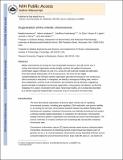| dc.contributor.author | Naumova, Natalia | |
| dc.contributor.author | Zhan, Ye | |
| dc.contributor.author | Lajoie, Bryan R. | |
| dc.contributor.author | Dekker, Job | |
| dc.contributor.author | Imakaev, Maksim Viktorovich | |
| dc.contributor.author | Fudenberg, Geoffrey | |
| dc.contributor.author | Mirny, Leonid A | |
| dc.date.accessioned | 2017-12-19T18:10:56Z | |
| dc.date.available | 2017-12-19T18:10:56Z | |
| dc.date.issued | 2013-11 | |
| dc.date.submitted | 2013-02 | |
| dc.identifier.issn | 0036-8075 | |
| dc.identifier.issn | 1095-9203 | |
| dc.identifier.uri | http://hdl.handle.net/1721.1/112804 | |
| dc.description.abstract | Mitotic chromosomes are among the most recognizable structures in the cell, yet for over a century their internal organization remains largely unsolved. We applied chromosome conformation capture methods, 5C and Hi-C, across the cell cycle and revealed two alternative three-dimensional folding states of the human genome. We show that the highly compartmentalized and cell-type-specific organization described previously for non-synchronous cells is restricted to interphase. In metaphase, we identify a homogenous folding state, which is locus-independent, common to all chromosomes, and consistent among cell types, suggesting a general principle of metaphase chromosome organization. Using polymer simulations, we find that metaphase Hi-C data are inconsistent with classic hierarchical models, and is instead best described by a linearly-organized longitudinally compressed array of consecutive chromatin loops. | en_US |
| dc.description.sponsorship | National Cancer Institute (U.S.) (Grant U54CA143874) | en_US |
| dc.publisher | American Association for the Advancement of Science (AAAS) | en_US |
| dc.relation.isversionof | http://science.sciencemag.org/content/342/6161/948 | en_US |
| dc.rights | Creative Commons Attribution-Noncommercial-Share Alike | en_US |
| dc.rights.uri | http://creativecommons.org/licenses/by-nc-sa/4.0/ | en_US |
| dc.source | PMC | en_US |
| dc.title | Organization of the Mitotic Chromosome | en_US |
| dc.type | Article | en_US |
| dc.identifier.citation | Naumova, Natalia et al. "Organization of the Mitotic Chromosome." Science 342, 6161 (November 2013): 948-953 © 2013 American Association for the Advancement of Science | en_US |
| dc.contributor.department | Institute for Medical Engineering and Science | en_US |
| dc.contributor.department | Massachusetts Institute of Technology. Department of Physics | en_US |
| dc.contributor.mitauthor | Imakaev, Maksim Viktorovich | |
| dc.contributor.mitauthor | Fudenberg, Geoffrey | |
| dc.contributor.mitauthor | Mirny, Leonid A | |
| dc.relation.journal | Science | en_US |
| dc.eprint.version | Author's final manuscript | en_US |
| dc.type.uri | http://purl.org/eprint/type/JournalArticle | en_US |
| eprint.status | http://purl.org/eprint/status/PeerReviewed | en_US |
| dc.date.updated | 2017-12-18T21:14:46Z | |
| dspace.orderedauthors | Naumova, Natalia; Imakaev,Maxim; Fudenberg, Geoffrey; Zhan, Ye; Lajoie,Bryan R.; Mirny, Leonid A.; Dekker, Job | en_US |
| dspace.embargo.terms | N | en_US |
| dc.identifier.orcid | https://orcid.org/0000-0002-5320-2728 | |
| dc.identifier.orcid | https://orcid.org/0000-0001-5905-6517 | |
| dc.identifier.orcid | https://orcid.org/0000-0002-0785-5410 | |
| mit.license | OPEN_ACCESS_POLICY | en_US |
